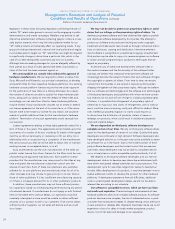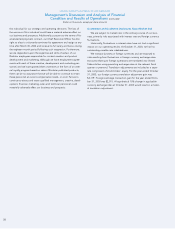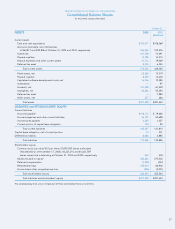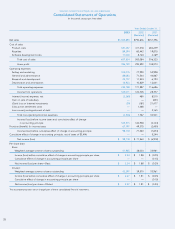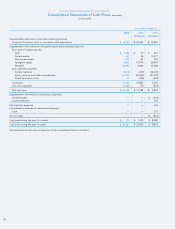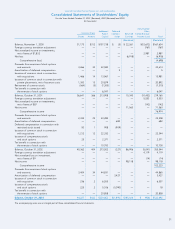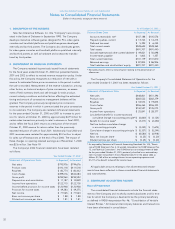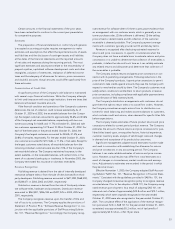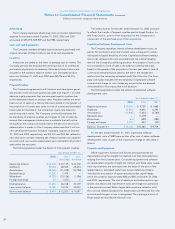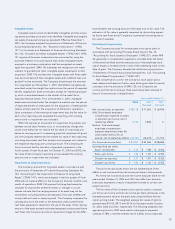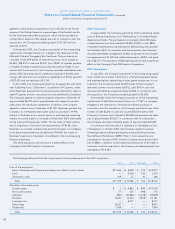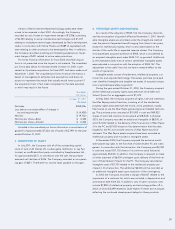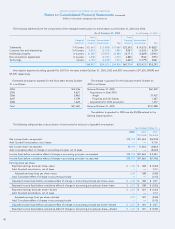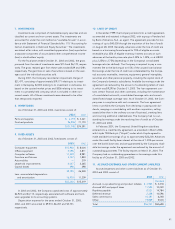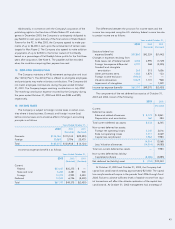2K Sports 2003 Annual Report Download - page 36
Download and view the complete annual report
Please find page 36 of the 2003 2K Sports annual report below. You can navigate through the pages in the report by either clicking on the pages listed below, or by using the keyword search tool below to find specific information within the annual report.
Advertising
The Company expenses advertising costs as incurred. Advertising
expense for the years ended October 31, 2003, 2002 and 2001
amounted to $55,795, $39,909 and $22,983, respectively.
Cash and Cash Equivalents
The Company considers all highly liquid instruments purchased with
original maturities of three months or less to be cash equivalents.
Inventory
Inventories are stated at the lower of average cost or market. The
Company periodically evaluates the carrying value of its inventories
and makes adjustments as necessary. Estimated product returns are
included in the inventory balance at their cost. Estimated product
returns at October 31, 2003 and 2002 were $8,706 and $5,015,
respectively.
Prepaid Royalties
The Company’s agreements with licensors and developers gener-
ally provide it with exclusive publishing rights and require it to make
advance royalty payments that are recouped against royalties due
to the developer based on product sales. Prepaid royalties are amor-
tized as cost of sales on a title-by-title basis, based on the greater of
the proportion of current year sales to total of current and estimated
future sales for that title or the contractual royalty rate based on
actual net product sales. The Company continually evaluates the
recoverability of prepaid royalties and charges to cost of sales the
amount that management determines is probable that will not be
recouped at the contractual royalty rate in the period in which such
determination is made or if the Company determines that it will can-
cel a development project. Included in prepaid royalties at October
31, 2003 and 2002, respectively, are $14,241 and $22,561 related to
titles that have not been released yet. Prepaid royalties are classified
as current and non-current assets based upon estimated net product
sales within the next year.
The following table provides the details of total prepaid royalties:
Years Ended October 31,
2003 2002 2001
(Restated) (Restated)
Beginning balance $ 26,418 $ 33,149 $ 24,718
Additions 30,034 28,555 25,423
Amortization (19,065) (21,238) (15,798)
Reclassification (7,251) 1,419 —
Write-down (9,525) (15,126) (1,196)
Foreign exchange 24 (341) 2
Ending balance 20,635 26,418 33,149
Less current balance 12,196 14,215 22,052
Non-current balance $ 8,439 $ 12,203 $ 11,097
The reclassification for the year ended October 31, 2003 principal-
ly reflects the transfer of prepaid royalties paid to Angel Studios, Inc.
and Frog City, Inc. prior to their acquisition by the Company as a
component of the purchase price of the acquisitions.
Capitalized Software Development Costs
The Company capitalizes internal software development costs, as
well as film production and other content costs, subsequent to estab-
lishing technological feasibility of a title. Capitalized software develop-
ment costs represent the costs associated with the internal develop-
ment of the Company’s publishing products. Amortization of such costs
as a component of cost of sales is recorded on a title-by-title basis,
based on the greater of the proportion of current year sales to total of
current and estimated future sales for the title or the straight-line
method over the remaining estimated useful life of the title. The Com-
pany continually evaluates the recoverability of capitalized software
costs and will charge to cost of sales any amounts that are deemed
unrecoverable or for projects that it will abandon.
The following table provides the details of capitalized software
development costs:
Years Ended October 31,
2003 2002 2001
Beginning balance $ 10,385 $ 9,739 $ 7,668
Additions 15,923 9,645 6,293
Amortization (10,940) (7,633) (3,780)
Reclassification —(1,419) —
Write-down (63) (490) (389)
Foreign exchange 1,031 543 (53)
Balance, October 31 $ 16,336 $10,385 $ 9,739
For the year ended October 31, 2001, capitalized software
development costs of $389 were written off as cost of sales—software
development costs, as part of the impairment charge as described in
Note 4.
Property and Equipment
Office equipment, furniture and fixtures and automobiles are
depreciated using the straight-line method over their estimated lives
ranging from five to seven years. Computer equipment and software
are depreciated using the straight-line method over three years. Lease-
hold improvements are amortized over the lesser of the term of the
related lease or estimated useful lives. Accumulated amortization
includes the amortization of assets recorded under capital leases,
which amounted to approximately $88 and $92 at October 31, 2003
and 2002, respectively. The cost of additions and betterments is capi-
talized, and repairs and maintenance costs are charged to operations
in the periods incurred. When depreciable assets are retired or sold,
the cost and related allowances for depreciation are removed from the
accounts and the gain or loss is recognized. The carrying amounts of
these assets are recorded at historical cost.
TAKE-TWO INTERACTIVE SOFTWARE, INC. AND SUBSIDIARIES
Notes to Consolidated Financial Statements (continued)
(Dollars in thousands, except per share amounts)
34


